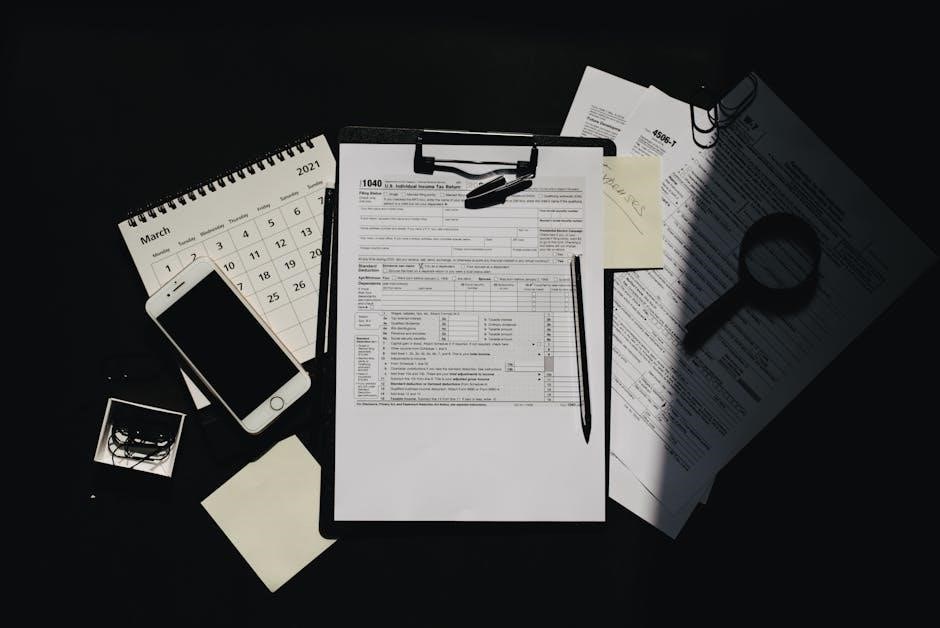
form 990 instructions schedule l
Form 990 is the annual information return for tax-exempt organizations‚ ensuring transparency and compliance. Schedule L specifically reports transactions with interested persons‚ promoting accountability and ethical practices.
Overview of Form 990
Form 990 is the annual information return required for most tax-exempt organizations‚ detailing financial activities‚ governance policies‚ and public benefit efforts. It ensures transparency and accountability‚ providing the IRS and the public with insights into an organization’s operations and compliance; The form includes sections on income‚ expenses‚ assets‚ and liabilities‚ as well as disclosures about governance practices and related-party transactions. It is a critical tool for maintaining tax-exempt status and public trust.
Purpose of Schedule L in Form 990
Schedule L is a supplemental form to the IRS Form 990‚ focusing on reporting certain financial transactions between the nonprofit organization and its interested persons. Its purpose is to ensure transparency and accountability by disclosing transactions such as loans‚ grants‚ or sales that could pose conflicts of interest or improper benefits. This schedule helps maintain public trust and compliance with IRS regulations‚ ensuring ethical financial practices within tax-exempt organizations.

Understanding Schedule L
Schedule L is a section of Form 990 detailing transactions with interested persons‚ ensuring transparency and accountability. It reports loans‚ sales‚ and other financial dealings.
Definition and Scope of Schedule L
Schedule L is a section of Form 990 detailing transactions with interested persons‚ ensuring transparency and accountability. It reports loans‚ sales‚ and other financial dealings exceeding $5‚000‚ applicable to organizations filing Form 990‚ 990-EZ‚ or 990-PF. This ensures compliance with IRS regulations and maintains public trust in tax-exempt entities.
Key Components of Schedule L
Schedule L requires detailed reporting of transactions with interested persons‚ including loans‚ grants‚ sales‚ and asset transfers exceeding $5‚000. It also discloses compensation and business relationships involving officers‚ directors‚ and key employees. The schedule ensures transparency by listing each transaction’s nature‚ amount‚ and purpose‚ promoting accountability and compliance with IRS regulations for tax-exempt organizations.

Purpose and Importance of Schedule L
Schedule L ensures transparency and accountability by reporting transactions with interested persons‚ promoting ethical practices and compliance with IRS regulations for tax-exempt organizations.
Why Schedule L is Essential for Nonprofits
Schedule L is crucial for nonprofits as it ensures transparency and accountability by detailing financial transactions with insiders. This disclosure helps prevent conflicts of interest‚ maintains public trust‚ and ensures compliance with IRS regulations‚ which is vital for preserving tax-exempt status and fostering a culture of integrity within the organization.
Consequences of Not Filing Schedule L
Failing to file Schedule L can result in penalties‚ including fines and potential loss of tax-exempt status. The IRS may impose fees for late or incomplete filings‚ and repeated noncompliance can lead to revoked exempt status. Additionally‚ nonprofits risk losing public trust and credibility due to lack of transparency‚ which is essential for maintaining donor and stakeholder confidence.

Structure of Schedule L
Schedule L consists of sections detailing transactions with interested persons‚ including compensation‚ business relationships‚ and loans. Each part is clearly defined to ensure accurate reporting compliance.
Sections and Parts of Schedule L
Schedule L is divided into clear sections and parts‚ each addressing specific transactions. Part I covers financial transactions with interested persons‚ while Part II details loans and other extensions of credit. Part III focuses on grants or assistance benefiting interested persons. Each section requires detailed disclosures‚ ensuring transparency and accountability in nonprofit operations‚ as outlined in IRS guidelines.
Instructions for Completing Each Section
Each section of Schedule L requires precise reporting. Part I demands detailed disclosure of financial transactions with interested persons‚ including amounts and relationships. Part II focuses on loans‚ specifying terms and repayment status. Part III requires documentation of grants or assistance to interested persons. Accurate reporting‚ proper documentation‚ and adherence to IRS guidelines are essential to ensure compliance and maintain transparency in nonprofit operations.

Eligibility for Filing Schedule L
Schedule L must be filed if the organization answered “Yes” to Form 990‚ Part IV‚ line 25‚ or had transactions exceeding $50‚000 with interested persons.
Who Must File Schedule L
Organizations must file Schedule L if they answer “Yes” to Form 990‚ Part IV‚ line 25‚ or have transactions exceeding $50‚000 with interested persons. This includes officers‚ directors‚ key employees‚ and substantial contributors. The threshold applies to aggregate transactions‚ ensuring transparency in financial dealings that could pose conflicts of interest. Accurate reporting is crucial for maintaining tax-exempt status and public trust.
Exceptions and Special Cases
Certain entities are exempt from filing Schedule L‚ such as churches and integrated auxiliary organizations. Additionally‚ de minimis transactions below $50‚000 may not require reporting. However‚ specific conditions apply‚ and organizations must carefully review IRS guidelines to determine if exceptions apply. Proper documentation and legal consultation are advised to ensure compliance with all regulatory requirements for accurate and lawful filings.
Instructions for Completing Schedule L
Schedule L requires detailed reporting of transactions with interested persons. Ensure accurate disclosure and compliance with IRS guidelines. Adherence to specific instructions is crucial to avoid errors and ensure proper documentation.
Step-by-Step Guide to Filing Schedule L
Filing Schedule L requires careful preparation. Start by identifying all transactions with interested persons‚ such as officers or key employees. Gather necessary documentation‚ including amounts and descriptions of each transaction. Complete each section systematically‚ ensuring accuracy and compliance with IRS guidelines. Review for completeness and adherence to reporting thresholds. Submit alongside Form 990‚ adhering to deadlines. Ensure transparency and avoid errors to maintain compliance and public trust.
Common Mistakes to Avoid
Common errors include missing deadlines‚ incomplete disclosures‚ and incorrect valuations. Ensure all transactions with interested persons are reported accurately. Avoid omitting required details‚ such as descriptions or amounts. Double-check calculations to prevent mathematical errors. failure to file on time or omitting Schedule L entirely can lead to penalties. Always review IRS guidelines and seek professional advice if unsure to ensure compliance and avoid costly mistakes.
Transactions That Must Be Reported
Transactions with interested persons‚ such as officers‚ directors‚ and key employees‚ must be disclosed. Include details like descriptions‚ amounts‚ and purposes to ensure transparency and compliance.
Definition of Reportable Transactions
Reportable transactions under Schedule L include sales‚ purchases‚ leases‚ or other financial arrangements between the nonprofit and interested persons. These transactions must be disclosed if they exceed $50‚000 or involve certain terms. The IRS defines interested persons as officers‚ directors‚ key employees‚ or substantial contributors. Accurate reporting ensures transparency and compliance‚ avoiding penalties for non-disclosure or improper dealings.
Examples of Reportable Transactions
Examples of reportable transactions include sales‚ purchases‚ leases‚ or loans between the nonprofit and interested persons. For instance‚ selling property to a board member or leasing space from a key employee. Asset transfers‚ compensation arrangements‚ and business deals with substantial contributors also qualify. These transactions must be disclosed if they exceed $50‚000 or involve specific terms‚ ensuring transparency and compliance with IRS regulations.

Filing Requirements and Deadlines
Form 990 is due by the 15th day of the fifth month after the tax year ends. File accurately to avoid penalties and ensure compliance.
When to File Schedule L
Schedule L must be filed with Form 990 by the 15th day of the fifth month after the organization’s tax year ends. Ensure timely submission to avoid penalties. If the deadline falls on a weekend or federal holiday‚ the filing is due the next business day. Accuracy and compliance are crucial to maintaining tax-exempt status. Late or incomplete filings can result in IRS notices or penalties‚ so careful preparation is essential. Plan accordingly to meet the deadline.
Where to Submit Schedule L
Schedule L must be submitted to the IRS along with Form 990; Organizations can file electronically through IRS-approved e-file providers or by mailing the completed form to the address listed in the Form 990 instructions. For paper filers‚ the address is typically IRS‚ Ogden UT 84201-0027. Ensure the correct address is used to avoid processing delays. Visit the IRS website for the most current filing information and guidelines.
Public Disclosure of Schedule L
Public disclosure of Schedule L ensures transparency‚ making transactions with interested persons accessible. The IRS requires organizations to provide Form 990‚ including Schedule L‚ upon request‚ promoting accountability and trust.
How Schedule L Information is Made Public
Schedule L information is made public through the IRS website and public inspection. The IRS requires tax-exempt organizations to make their Form 990‚ including Schedule L‚ available for public review. Copies can also be obtained by requesting them directly from the IRS or the organization itself. This ensures transparency and accountability‚ allowing stakeholders to access detailed financial transactions and governance practices. Redactions are made for sensitive information to protect privacy.
Implications of Public Disclosure
Public disclosure of Schedule L ensures transparency and accountability for tax-exempt organizations. It allows donors‚ grantors‚ and the public to scrutinize financial transactions‚ fostering trust and oversight. Organizations must be prepared for heightened scrutiny‚ as disclosed information may influence donor decisions and media attention. Noncompliance with disclosure requirements can lead to penalties‚ damaging an organization’s reputation and tax-exempt status. Accurate reporting is essential to maintain public confidence and regulatory compliance.
Practical Tips for Accurate Completion
Use advanced search features to refine results‚ ensuring precise information retrieval. Employ synonyms and specific search strategies to enhance accuracy and efficiency in completing Schedule L.
Best Practices for Filing Schedule L
- Review the IRS instructions thoroughly to understand reporting requirements for transactions with interested persons.
- Ensure accurate and complete disclosure of all financial details to maintain compliance and avoid penalties.
- Double-check calculations and verify consistency with Form 990 before submission.
- Utilize tools like Google’s advanced search features for quick access to relevant IRS guidelines.
- Maintain organized records of all transactions to facilitate seamless reporting.
These practices ensure transparency‚ accuracy‚ and compliance‚ simplifying the filing process for nonprofits.
Tools and Resources for Assistance
- The IRS website offers official instructions and forms for Schedule L‚ ensuring accurate compliance.
- Utilize IRS publications and guides for detailed explanations of reporting requirements.
- Leverage Google’s advanced search to quickly find relevant IRS resources and examples.
- Consult nonprofit webinars and workshops for practical tips on filing Schedule L.
- Use tax software designed for nonprofits to streamline data entry and reduce errors.
These tools and resources provide essential support for accurate and efficient filing of Schedule L.

IRS Resources and Guidance
The IRS provides official instructions for Schedule L and related forms on its website. Access Publication 557 and the IRS Tax Exempt Organization Search for detailed guidance and compliance support.
Official IRS Instructions for Schedule L
The IRS offers detailed instructions for Schedule L within the Form 990 guidelines. These instructions outline reporting requirements‚ define interested persons‚ and explain how to disclose transactions. The IRS website provides access to the most recent versions of Schedule L and related forms‚ ensuring compliance with current tax regulations. Additionally‚ Publication 557 and the IRS Tax Exempt Organization Search tool are valuable resources for understanding and accurately filing Schedule L.
Additional IRS Publications and Forms
Beyond Schedule L‚ the IRS provides essential resources like Form 1023 for exemption applications and Form 990-EZ for smaller organizations. Publication 557 offers detailed guidance on tax-exempt status‚ while Form 8802 aids in requesting residency certifications. The IRS Tax Exempt Organization Search tool and Form W-9 for EIN verification are also crucial for compliance and accurate filings‚ ensuring nonprofits meet all regulatory requirements efficiently.

Common Pitfalls and Solutions
Common errors include inaccurate reporting of transactions and insufficient disclosures. Ensure all required information is accurately reported and thoroughly documented to avoid penalties. Consult IRS guidelines for clarity and compliance.
Common Errors in Schedule L Filings
Common errors in Schedule L filings include inaccurate reporting of transactions with interested persons‚ failure to disclose material financial interests‚ and misclassifying transactions. Organizations often overlook requiring detailed documentation for substantial transactions or incorrectly calculating thresholds for reporting. Additionally‚ noncompliance with disclosure requirements and incomplete or inconsistent information can lead to penalties. Ensuring thorough documentation and consulting IRS guidelines can help mitigate these issues and ensure accurate compliance.
How to Correct Filing Mistakes
If errors are discovered in Schedule L‚ filers should promptly submit an amended Form 990‚ including corrected schedules. Use Form 990’s instructions to identify the specific section needing correction. Clearly explain the changes in Schedule O or an attached statement. Ensure all revisions align with IRS guidelines to avoid penalties and maintain compliance. Timely corrections help preserve the organization’s good standing and public trust.

Case Studies and Examples
A nonprofit corrected a Schedule L error by amending Form 990‚ ensuring accurate reporting of transactions with interested persons and maintaining transparency in financial disclosures.
Real-Life Examples of Schedule L Filings
A nonprofit organization reported a transaction with a board member‚ detailing the exchange of services and fair market value‚ ensuring compliance with IRS transparency requirements. Another example involved a charity correcting a Schedule L error by amending Form 990‚ highlighting the importance of accurate reporting. These cases demonstrate how nonprofits navigate complex financial disclosures‚ ensuring accountability and adherence to tax-exempt regulations. Proper documentation and ethical practices are essential.
Lessons Learned from Successful Filings
Successful Schedule L filings emphasize the importance of accuracy and transparency in reporting transactions. Nonprofits should maintain thorough documentation and ensure all disclosures align with IRS guidelines. Promptly addressing errors and amending filings when necessary demonstrates accountability. Consistent compliance with reporting requirements builds trust and avoids penalties. By prioritizing ethical practices and clear communication‚ organizations can achieve seamless Schedule L filings and uphold their tax-exempt status effectively.
Accurate Schedule L reporting is crucial for nonprofits to maintain compliance and transparency‚ ensuring accountability and upholding tax-exempt status through ethical disclosures and adherence to IRS guidelines.
Schedule L is essential for nonprofits to report transactions with interested persons‚ ensuring transparency and compliance. Understanding its structure‚ including sections and instructions‚ is vital for accurate filing. Proper disclosure helps maintain tax-exempt status and public trust‚ while errors or omissions can lead to penalties. Adhering to IRS guidelines and seeking professional guidance ensures compliance and avoids legal consequences‚ making Schedule L a critical component of Form 990 filings.
Final Thoughts on Schedule L Compliance
Schedule L compliance is critical for maintaining transparency and accountability in nonprofit operations. Accurate and timely reporting ensures adherence to IRS regulations‚ avoiding penalties or loss of tax-exempt status. Understanding the requirements and seeking professional guidance when needed is essential. By prioritizing compliance‚ organizations uphold their integrity and public trust‚ ensuring continued operational success and fiscal responsibility.

Frequently Asked Questions
- Who must file Schedule L? Organizations with transactions exceeding $5‚000 with interested persons must file it.
- What transactions are reportable? Loans‚ grants‚ and business dealings with insiders or related entities are typically reported.
- What if I fail to file correctly? Penalties‚ fines‚ or loss of tax-exempt status may occur for noncompliance.
- Should I seek professional help? Yes‚ consulting a tax expert ensures accurate and timely filing of Schedule L.
Common Questions About Schedule L
What transactions must be reported on Schedule L? Organizations must disclose loans‚ grants‚ and business dealings with interested persons. How do I determine an interested person? Typically‚ it includes officers‚ directors‚ or key employees. What are the penalties for not filing correctly? Noncompliance may result in fines or loss of tax-exempt status. Should I consult a professional? Yes‚ experts can ensure accurate filing and avoid errors. When is Schedule L due? It must be submitted with Form 990 by the organization’s tax filing deadline. Where can I find more guidance? The IRS provides detailed instructions and resources online. Are there exceptions? Some smaller organizations may be exempt‚ but most must comply. How do I avoid common mistakes? Carefully review instructions and cross-verify data before submission.
Expert Answers and Clarifications
Experts clarify that Schedule L ensures transparency by requiring nonprofits to report transactions with interested persons. Properly identifying these individuals is crucial‚ as failure to disclose can lead to penalties. The IRS provides detailed instructions to guide accurate reporting. Consulting a tax professional is highly recommended to navigate complex filing requirements and avoid common errors. Ensuring compliance with Schedule L is essential for maintaining tax-exempt status and public trust in the organization.
Leave a Reply
You must be logged in to post a comment.